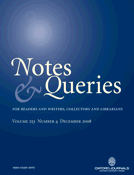
Edward Lear was an English artist, illustrator, musician, author and poet, now known mostly for his literary nonsense in poetry and prose and especially his limericks, a form he popularised. His principal areas of work as an artist were threefold: as a draughtsman employed to illustrate birds and animals; making coloured drawings during his journeys, which he reworked later, sometimes as plates for his travel books; as a (minor) illustrator of Alfred, Lord Tennyson's poems. As an author, he is known principally for his popular nonsense collections of poems, songs, short stories, botanical drawings, recipes, and alphabets. He also composed and published twelve musical settings of Tennyson's poetry.

The Oxford English Dictionary (OED) is the principal historical dictionary of the English language, published by Oxford University Press. It traces the historical development of the English language, providing a comprehensive resource to scholars and academic researchers, as well as describing usage in its many variations throughout the world. The second edition, comprising 21,728 pages in 20 volumes, was published in 1989.

The Dictionary of National Biography (DNB) is a standard work of reference on notable figures from British history, published since 1885. The updated Oxford Dictionary of National Biography (ODNB) was published on 23 September 2004 in 60 volumes and online, with 50,113 biographical articles covering 54,922 lives.

The great horned owl, also known as the tiger owl or the hoot owl, is a large owl native to the Americas. It is an extremely adaptable bird with a vast range and is the most widely distributed true owl in the Americas. Its primary diet is rabbits and hares, rats and mice, and voles, although it freely hunts any animal it can overtake, including rodents and other small mammals, larger mid-sized mammals, birds, reptiles, amphibians, and invertebrates. In ornithological study, the great horned owl is often compared to the Eurasian eagle-owl, a closely related species, which despite the latter's notably larger size, occupies the same ecological niche in Eurasia, and the red-tailed hawk, with which it often shares similar habitat, prey, and nesting habits by day, thus is something of a diurnal ecological equivalent. The great horned owl is one of the earliest nesting birds in North America, often laying eggs weeks or even months before other raptorial birds.

The barred owl, also known as northern barred owl or hoot owl, is a true owl native to eastern North America. Adults are large, and are brown to grey with barring on the chest. Barred owls have expanded their range to the west coast of the United States and Canada, where they are considered invasive. Mature forests are their preferred habitat, but they are also found in open woodland areas. Their diet consists mainly of small mammals, but they are also known to prey upon other small animals such as birds, reptiles, and amphibians.

Notes and Queries is a long-running quarterly scholarly journal that publishes short articles related to "English language and literature, lexicography, history, and scholarly antiquarianism". Its emphasis is on "the factual rather than the speculative". The journal has a long history, having been established in 1849 in London; it is now published by Oxford University Press.

The Owl and the Nightingale is a twelfth- or thirteenth-century Middle English poem detailing a debate between an owl and a nightingale as overheard by the poem's narrator. It is the earliest example in Middle English of a literary form known as debate poetry.
Bandolier was an independent healthcare journal about evidence-based healthcare, written by Oxford University scientists. It was started in 1994 and the National Health Service paid for its distribution to all doctors in the UK until 2002. Publication of the printed version ceased in 2007. New material was published online through 2010. Publication ceased in 2010.
The Institute of Historical Research (IHR) is a British educational organisation providing resources and training for historical researchers. It is part of the School of Advanced Study in the University of London and is located at Senate House. The Institute was founded in 1921 by A. F. Pollard.
Owls are nocturnal birds of prey.

Wiley-Blackwell is the international scientific, technical, medical, and scholarly publishing business of John Wiley & Sons. It was formed by the merger of John Wiley's Global Scientific, Technical, and Medical business with Blackwell Publishing, after Wiley took over the latter in 2007.

Ian Robert Horrocks is a Professor of Computer Science at the University of Oxford in the UK and a Fellow of Oriel College, Oxford. His research focuses on knowledge representation and reasoning, particularly ontology languages, description logic and optimised tableaux decision procedures.
The Owl: a Wednesday journal of politics and society was a satirical society newspaper published in London from 1864 to 1870. Irregularly published, but sometimes fortnightly, it cost 6d., was Tory in politics and consisted of a mix of satire and London society gossip.
British Journal for the Philosophy of Science (BJPS) is a peer-reviewed, academic journal of philosophy, owned by the British Society for the Philosophy of Science (BSPS) and published by Oxford University Press. The journal publishes work that uses philosophical methods in addressing issues raised in the natural and human sciences.

The Jerusalem Review of Legal Studies is an English-language Israeli law journal covering books and research in legal theory. It is published by Oxford University Press in cooperation with the Hebrew University of Jerusalem. The editors-in-chief are Alon Harel and Ori Herstein. The journal is dedicated entirely to critical discussions of books or large research projects.
Heitor Villa-Lobos's Étude No. 12, the last of his Twelve Études for Guitar, was first published by Max Eschig, Paris, in 1953.
Heitor Villa-Lobos's Étude No. 9, part of his Twelve Études for Guitar, was first published by Max Eschig, Paris, in 1953.
Heitor Villa-Lobos's Étude No. 11, one of his Twelve Études for Guitar, was first published by Max Eschig, Paris, in 1953.
Heitor Villa-Lobos's Étude No. 10, part of his Twelve Études for Guitar, was first published by Max Eschig, Paris, in 1953.











